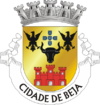Beja, Portugal
| Beja | |||
|---|---|---|---|
| Municipality | |||
 |
|||
|
|||
 |
|||
| Coordinates: 38°02′N 7°53′W / 38.033°N 7.883°WCoordinates: 38°02′N 7°53′W / 38.033°N 7.883°W | |||
| Country |
|
||
| Region | Alentejo | ||
| Subregion | Baixo Alentejo | ||
| Intermunic. comm. | Baixo Alentejo | ||
| District | Beja | ||
| Parishes | 11 | ||
| Government | |||
| • President | Francisco Santos (CDU) | ||
| Area | |||
| • Total | 1,146.44 km2 (442.64 sq mi) | ||
| Population (2011) | |||
| • Total | 35,854 | ||
| • Density | 31/km2 (81/sq mi) | ||
| Time zone | WET/WEST (UTC+0/+1) | ||
| Website | http://www.cm-beja.pt | ||
Beja (Portuguese pronunciation: [ˈbɛʒɐ]) is a city and a municipality in the Alentejo region, Portugal. The population in 2011 was 35,854, in an area of 1146.44 km². The city proper had a population of 21,658 in 2001.
The municipality is the capital of the Beja District. The present Mayor is João Rocha, elected by the Portuguese Communist Party with an absolute majority in the 2009 Portuguese Legislative elections. The municipal holiday is Ascension Day. The Portuguese Air Force has an airbase in the area – the Air Base No. 11.
Situated on a 277 metres (909 ft) hill, commanding a strategic position over the vast plains of the Baixo Alentejo, Beja was already an important place in antiquity. Already inhabited in Celtic times, the town was later named Pax Julia by Julius Caesar in 48 BCE, when he made peace with the Lusitanians. He raised the town to be the capital of the southernmost province of Lusitania (Santarém and Braga were the other capitals of the conventi). During the reign of emperor Augustus the thriving town became Pax Augusta. It was already then a strategic road junction.
When the Visigoths took over the region, the town, then called Paca, became the seat of a bishopric. Saint Aprígio (died in 530) became the first Visigothic bishop of Paca. The town fell to the invading Umayyad army in 713. Thus Paca, through Arabic Baja, became Beja.
...
Wikipedia


